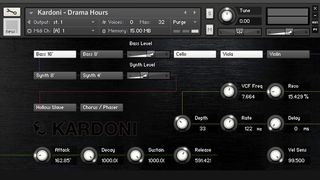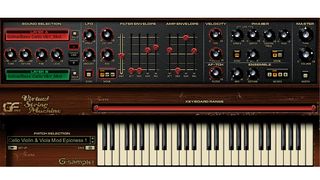Image courtesy of Perfect Circuit Audio
Legendary American synth manufacturer ARP produced more than its share of classic instruments: the semi-modular 2600 is rightly revered by old-school sound designers and the light and portable Odyssey much loved by veteran road warriors.
Surprisingly, though, ARP's biggest seller was actually the Omni - a paraphonic string machine with a few basic synthesis functions tacked on.
What made this instrument so popular? Not the price, to be sure. A brand new unit in 1975 would have cost you a whopping £1200. That's a lot of money today, but it was a small fortune in the economic ruin that was the 70s.
Features, then? Probably not - it was essentially a preset instrument that offered only a smattering of tweakable parameters; though it has to be said that the built-in synthesis sounded great and was more than capable of producing some thick, swirling textures.
It was, in fact, polyphony that made the Omni a must-have; or rather "paraphony", since it wasn't truly polyphonic, using the same divide-down technology found in cheap home organs to generate all those extra tones.
Nevertheless, you could play as many notes as you liked and, thanks to ARP's gorgeous four-pole filter, the synthesis section was rich and resonant.
"It was, in fact, polyphony that made the Omni a must-have; or rather "paraphony", since it wasn't truly polyphonic."
Early models offered only AR amplitude envelopes, while the Omni II got a full complement of Attack, Decay, Sustain and Release sliders. You could shape the filter using a dedicated envelope generator, and there was even an LFO, albeit outputting only a sine wave. Owners of the second generation of Omnis could avail themselves of a second LFO dedicated to the filter cutoff.
Add to this the ability to combine the synthesis functions with a four-part string section that included polyphonic violin and viola, and monophonic bass and cello timbres, and the Omni begins to look like the potentially invaluable accompaniment tool that it became for thousands of users. Among them were Tangerine Dream (of course), Kraftwerk and The Cars. The unmistakable sound of the Omni II featured heavily on classic cuts by Joy Division and, later, New Order, including the former's brilliant, brooding LP Closer.
It can be difficult to imagine now, but back in the 1970s, keyboardists had few options for playing chords, and even fewer of those options could be described as portable. The orchestral sounds that were popular at the time could only be provided by the real thing or, at best, by the cantankerous and unwieldy Mellotron and its ilk. The ability to 'fake' a string section with a relatively portable electronic instrument made the Omni and other string machines indispensable to gigging musicians.
Today we can fit a fully multisampled orchestra onto a USB drive… So where does that leave the Omni? Possibly relegated to the cultural dustbin, but let's not be too hasty. The lust for vintage analogue instruments remains a driving force in the electronic music industry, and developers have provided a number of virtual emulations to slake the thirst of even the most ravenous retro-fetishist.
Three great Arp Omni emulations

Puremagnetik Kardoni, $15
A multisampled Omni Mk 2 for Ableton Live, Apple Logic and NI Kontakt at a bargain price, Puremagnetik's emulation includes all the modules of the original, as well as Hollow and Chorus Phaser layers. The Kontakt version is the most intuitive and flexible in terms of UI, but all three deliver the authentic goods, work well and sound great.
Find out more about Puremagnetik Kardoni

Boscomac The Chiller, Free
Reaktor users have plenty of options when it comes to synthetic strings, but for a pure New Wave tone, it's pretty hard to beat The Chiller, a free ensemble directly inspired by the ARP Omni. Featuring monophonic bass along with violas and violins that span the full keyboard range, The Chiller adds a super-simple reverb section to phaser, chorus and vibrato effects.
Download Boscomac The Chiller for Reaktor

GForce Virtual String Machine, £100
Virtual String Machine is nothing less than a loving homage to the classic string machines of yore. A sample-based instrument, it offers comprehensive multisampled sets from the ARP Omni as well as the ARP Quartet, Solina (the forefather of the Omni), Elka Rhapsody and many, many more. There are even a few sets from the Oberheim OB-8 and Xpander.


